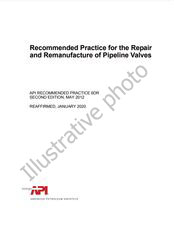We need your consent to use the individual data so that you can see information about your interests, among other things. Click "OK" to give your consent.

API PUBL 4643-ed.1996
Estimation of Infiltration and Recharge for Environmental Site Assessment
Translate name
STANDARD published on 1.7.1996
The information about the standard:
Designation standards: API PUBL 4643-ed.1996
Publication date standards: 1.7.1996
SKU: NS-1139810
The number of pages: 202
Approximate weight : 637 g (1.40 lbs)
Country: American technical standard
Category: Technical standards API
Annotation of standard text API PUBL 4643-ed.1996 :
API PUBL 4643, 1996 Edition, July 1996 - Estimation of Infiltration and Recharge for Environmental Site Assessment
Chemicals released into the vadose zone, from either accidental spills or wastes managed on the land, may migrate to groundwater, depending upon the nature of the release, design of the waste management facility, properties of the chemical, vadose zone characteristics, and leaching potential. Typically, quantitative analyses are required to assess whether such contaminant releases or leachate pose a threat to human health and the environment. For example, in promulgating the 1990 Toxicity Characteristic (TC) Rule, the U. S. Environmental Protection Agency (EPA) used a computer code called EPACML (EPAs Composite Model for Landfills) to estimate the potential human exposure to chemicals inappropriately disposed of in municipal landfills. Such chemical fate and transport analyses are an integral component of risk assessments required at sites remediated under the Comprehensive Environmental Response, Compensation and Liability Act (CERCLA). Similar computations are required in designing land treatment facilities for petroleum-contaminated soils and in evaluating risk-based alternatives at sites of fuel releases into the soil.
There are many analytical and numerical methods available to determine the mass flux of chemicals migrating by liquid-phase advection through the vadose zone into an aquifer. In virtually all instances, recharge is a key data need that must be prescribed in these calculations. Unfortunately, because of the difficulty in obtaining recharge values at a specific site, many analysts simply estimate the recharge rate based on their professional judgment, or they use model-embedded default parameters that are generally conservative for their purpose. A probabilistic approach such as a Monte Carlo analysis is sometimes used in risk assessments to address uncertainty in parameters. The probability of occurrence of a particular outcome is developed by making dozens or hundreds of calculations, each with a different set of parameters chosen at random and often without a sound basis for assessing the reasonableness of the parameters or the combinations of parameters randomly chosen. Regardless of the computational approach selected, sensitivity analyses of parameters commonly reveal that the mass flux of contaminants entering the aquifer is most strongly dependent on the recharge rate.
The objective of this report is to provide analysts a sound technical basis for selecting recharge values used in mass transport calculations, such as those required in risk-based corrective action (RBCA) assessments. The scope of the study is twofold:
- • Identify relevant techniques to quantify areally distributed, diffuse, natural recharge
- • Compile existing data on diffuse recharge throughout the United States
The approach to achieve these objectives was based on a search of existing literature contained in the in-house library of Daniel B. Stephens ? Associates, Inc., information from prior personal research and publications on recharge, computer database searches followed by retrieval of selected documents from the University of New Mexico library, and responses to requests for information from district offices of the U. S. Geological Survey throughout the country.
Section 2 of this report summarizes the concepts and terminology associated with the analysis of recharge. The report then presents a review of methods to quantify recharge in Section 3 and highlights results of previous studies to quantify recharge within subregions of the United States in Section 4. Also, included in Section 5 is a brief discussion of considerations for selecting recharge esturation techniques. Section 6 addresses technical issues for future research. A comprehensive glossary of terms used in this report is also provided.
We recommend:
Technical standards updating
Do you want to make sure you use only the valid technical standards?
We can offer you a solution which will provide you a monthly overview concerning the updating of standards which you use.
Would you like to know more? Look at this page.



 Cookies
Cookies
